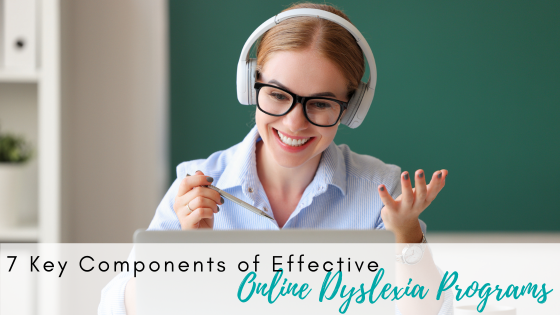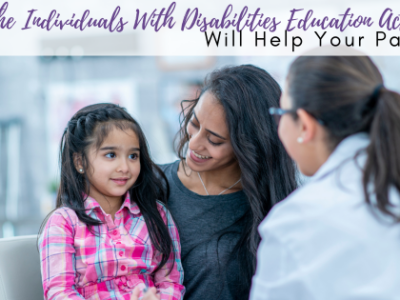
7 Key Components of Effective Online Dyslexia Programs
For parents of children with dyslexia, finding the right educational support can feel like navigating without a map; you have a desired outcome or destination for your child—you just don’t know the path to take to get there. If you’re a parent who feels a bit lost when it comes to finding the right dyslexia program for your child, know that online programs can help. Options such as traditional one-on-one tutoring can be expensive, geographically limited, and not quite as convenient as online dyslexia programs. Working with dyslexia specialists online can offer a promising route for families, and online programs can include added benefits like support, flexibility, and personalization. However, not all online dyslexia programs are created equal. Read on to learn more about 7 key components of effective online dyslexia programs.
-
- Evidence-Based, Data-driven Methodology: Seek out a dyslexia program that focuses on tried and true methods. Students should be evaluated through things like comprehensive reports, academic assessments, and academic samples. From there, informed diagnostic and prescriptive interventions should be put in place for students to help create high levels of accuracy, fluency, and independence in a student’s written language skills. Effective online programs should also be based on trusted approaches like Orton-Gillingham. This kind of instruction has been shown to help dyslexic students by focusing on explicit phonics instruction, phonemic awareness, and multisensory techniques. These methods help to engage auditory, visual, and kinesthetic learning styles.
- Personalized Learning Paths: The effects of dyslexia present themselves differently in each student, and the most effective online programs provide learning paths that are tailored to each child. Find an online dyslexia program that takes into account a student’s strengths, weaknesses, learning style, and personality. Aiming to customize this way—, implementing both one-on-one and group instruction—can address specific needs of a student and maximize a program’s effectiveness. When students receive interventions that are targeted, their specific needs are addressed. This helps students to improve with each online session and to experience a sense of ownership of their success.
- Engaging and Interactive: Online sessions need to captivate students through participation and interaction. The most effective online dyslexia programs incorporate activities that keep students motivated. Whether the curriculum components are gamified or there are reward systems, the lessons need to be effective for a variety of learning styles. Through engagement and interaction, students become more likely to attend, stay motivated, and complete their program successfully. Multisensory, tactile materials offer additional ways for students to be engaged, leading to better outcomes than just staring at a computer screen.
- Certified and Experienced Instructors: While working online is often done via video chat systems, the element of human interaction remains essential to the process. Experienced dyslexia specialists who are able to both instruct effectively and give guidance, feedback, and support are so key to successful programs. Seek a program that works with experts who have worked through rigorous training and evidence-based programs. Working closely with an instructor like a Certified Academic Language Therapist can both foster a sense of deeper understanding of material as well as a sense of connection for students.
- Progress Monitoring and Reporting: Actively monitoring and reporting on student progress are key components of effective online dyslexia programs. Regular reports help to point out a student’s areas of improvement as well as things that need more focus. An emphasis on progress helps to create a culture of collaborating among parents, instructors, and students. This helps to guide and inform a student’s learning throughout the program.
- Accessibility is essential: Ease of use is such an important part of successful online dyslexia programs. Being able to get connected with an instructor through clear navigation and a user-friendly interface can help with accessibility, frequency, and consistency.
- A Supportive Community: Dyslexia is a learning disability that doesn’t just affect the student. The best online dyslexia programs are able to provide more support than just a dyslexia curriculum. Additional resources, good contacts, webinars, and a strong community can help families and students to feel more connected with instructors.
When it comes to these 7 key components, Dyslexia on Demand offers them all through online dyslexia therapy programs. Working with Dyslexia on Demand ensures:
- An Orton-Gillingham based curriculum program that has been developed to enable students with dyslexia to achieve and maintain better reading fluency and word recognition.
- One-on-one instruction that helps students to connect and stay invested in their personal learning journey.
- Engaging sessions that occur with high frequency and fidelity of the multisensory delivery model
- Working with highly qualified Certified Academic Language Therapists.
- Continuous and consistent monitoring of student progress through both formal and informal measures
- Accessibility through online sessions.
- A great community and connection to others through Dyslexia on Demand.
Dyslexia on Demand has a mission to make dyslexia therapy accessible to students—no matter their geographical limitations. All learners deserve the opportunity to become lifelong learners who are academically successful. Reach out to Dyslexia on Demand to learn more about why our online dyslexia therapy could be a great option for you. Contact Dyslexia on Demand to learn more.







